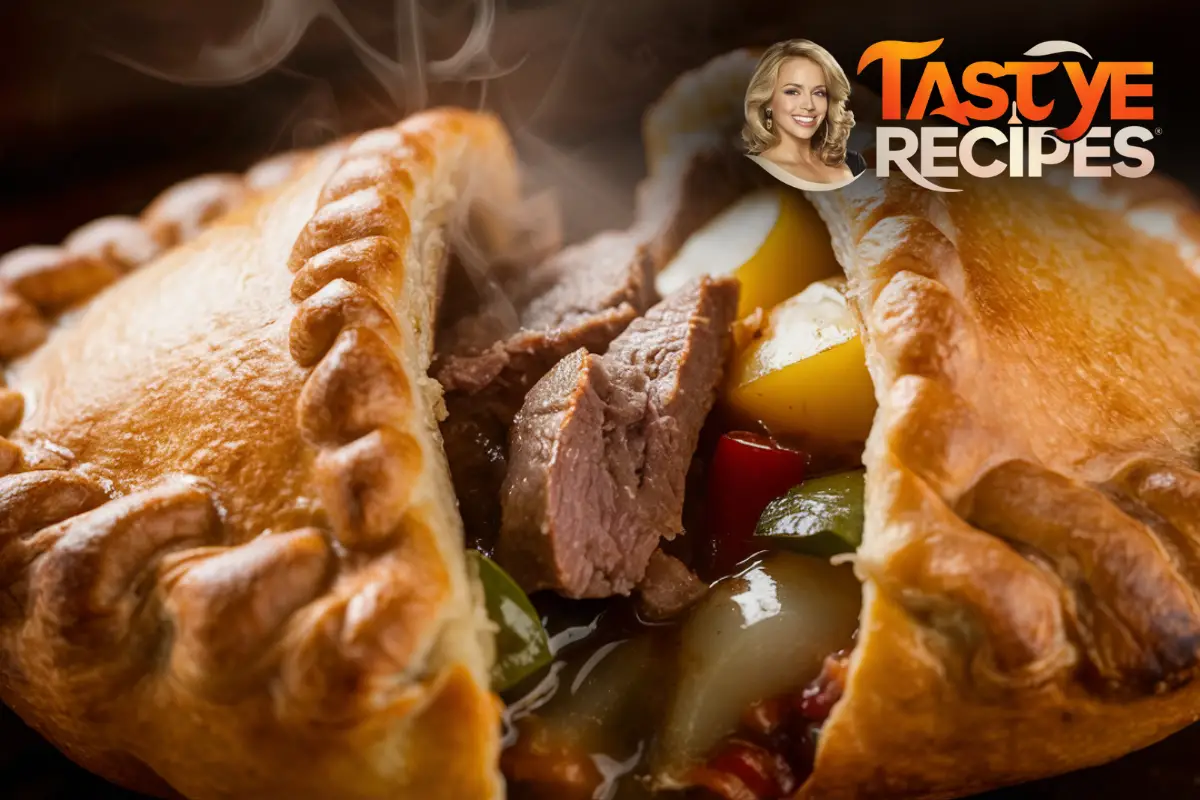Cornish Pasty
The Cornish Pasty, a beloved traditional British dish, originates from Cornwall, England. This hearty hand-held pie features a flaky pastry and savory filling, typically consisting of beef, potatoes, turnips (known as swedes in the UK), and onions. The distinct D-shape and crimped edge of the pasty not only add to its aesthetic appeal but also seal in the flavorful juices. Historically, Cornish miners favored the Cornish Pasty as a convenient and nourishing meal, providing a portable and robust lunch that could be eaten easily underground. Today, people continue to enjoy the Cornish Pasty as a popular snack and meal, celebrated for its comforting flavors and satisfying nature. Whether enjoyed hot or cold, this iconic dish offers a taste of British culinary heritage.
Ingredients for Cornish Pasty
To make a traditional Cornish Pasty, you will need a few essential ingredients. Shortcrust pastry serves as the dough, providing a sturdy and flaky exterior. The filling typically includes beef skirt or chuck steak, which is diced into small pieces. Potatoes and turnips (swedes) add a starchy component, while onions bring a touch of sweetness. Salt and black pepper are the primary seasonings, with some recipes also including a bit of thyme or parsley for additional flavor. To seal the pasty, a simple egg wash made from beaten egg is applied to the edges of the pastry before baking. Additionally, you may want to have some flour on hand for dusting and rolling out the pastry.
Preparing the Cornish Pasty
Making the Pastry
Start by preparing the shortcrust pastry. In a large mixing bowl, combine flour and a pinch of salt. Add cold, cubed butter, and rub it into the flour using your fingertips until the mixture resembles coarse crumbs. Gradually add cold water, a tablespoon at a time, mixing until the dough comes together. The dough should be firm but not sticky. Turn the dough out onto a floured surface and knead it gently to bring it together. Wrap the dough in plastic wrap and refrigerate it for at least 30 minutes to allow it to rest and firm up. This step is crucial for achieving a flaky and tender crust.
Preparing the Filling
While the pastry chills, prepare the filling. Peel and dice the potatoes and turnips into small, even pieces, ensuring they are all similar in size to promote even cooking. Dice the beef skirt or chuck steak into small cubes, and finely chop the onion. In a large bowl, combine the diced beef, potatoes, turnips, and onions. Season generously with salt and black pepper, and mix everything together until evenly distributed. For added flavor, you can sprinkle in some thyme or parsley, though this is optional.
Assembling the Pasties
Preheat your oven to 400°F (200°C). Remove the pastry dough from the refrigerator and divide it into equal portions, typically making 4-6 pasties depending on the desired size. Roll out each portion into a round disc, about 1/8 inch thick. Place a generous amount of filling on one half of the pastry disc, leaving a border around the edge. Brush the edges with beaten egg to help seal the pasty. Fold the other half of the pastry over the filling to form a half-moon shape. Press the edges together firmly and crimp them using your fingers or a fork to create a decorative seal. Repeat with the remaining dough and filling.
Baking the Pasties
Place the assembled pasties on a baking sheet lined with parchment paper. Brush the tops with the remaining beaten egg, which helps the pastry develop a golden-brown color and shiny finish. Use a small knife to make a few slits on the top of each pasty to allow steam to escape during baking. Bake the pasties in the preheated oven for 35-40 minutes, or until they turn golden brown and the filling is fully cooked. The pastry should be crisp and flaky, and the filling tender and flavorful. Remove from the oven and let the pasties cool slightly before serving.
Serving Suggestions
Cornish Pasties are versatile and can be enjoyed hot or cold, making them suitable for various occasions. Serve them as a main dish with a side salad, coleslaw, or steamed vegetables for a balanced meal. They are also delicious as a portable lunch or snack, perfect for picnics, lunchboxes, or on-the-go meals. For a traditional Cornish experience, enjoy the pasties with a dollop of mustard or a tangy chutney. A cup of tea or a pint of ale complements the flavors beautifully, making for a satisfying and hearty dining experience. The Cornish Pasty’s robust nature makes it a comforting choice for any meal.
Nutritional Information and Benefits
Cornish Pasties provide a balanced combination of protein, carbohydrates, and fats. The beef offers a good source of protein and essential nutrients like iron and B vitamins. Potatoes and turnips contribute fiber, vitamins, and minerals, supporting overall health. While the pastry adds fat and calories, using a moderate amount and opting for lean cuts of beef can help manage the dish’s nutritional profile. Including a variety of vegetables in the filling enhances the pasty’s nutritional value. As with many traditional dishes, enjoying Cornish Pasties in moderation as part of a balanced diet allows you to savor their flavors without overindulging.
Storage and Reheating
Cornish Pasties can be stored and reheated, making them convenient for meal prep or leftovers. To store, allow the pasties to cool completely, then wrap them individually in plastic wrap or aluminum foil. Place the wrapped pasties in an airtight container or a zip-top bag and refrigerate them for up to three days. For longer storage, they can be frozen for up to three months. To reheat, preheat your oven to 350°F (175°C) and warm the pasties on a baking sheet for about 15-20 minutes, or until heated through. If reheating from frozen, extend the time to 30-35 minutes. Avoid microwaving, as it can make the pastry soggy.
Safety Tips
When preparing Cornish Pasties, it’s important to handle raw meat and vegetables properly to avoid cross-contamination. Use separate cutting boards and utensils for meat and vegetables, and wash your hands thoroughly after handling raw ingredients. Ensure that the beef is cooked to a safe internal temperature, especially if using ground meat. When storing leftovers, refrigerate them promptly and consume them within a safe timeframe. Proper handling and storage ensure that your Cornish Pasties are safe to eat and maintain their delicious flavor and texture.
Frequently Asked Questions
Can I use a different type of meat for the filling?
Yes, you can substitute the beef with lamb, chicken, or even a meatless option like mushrooms or lentils for a vegetarian version.
What if I don’t have turnips?
You can replace turnips with rutabaga, parsnips, or even more potatoes if turnips are unavailable.
Is it necessary to use shortcrust pastry?
While shortcrust pastry is traditional for Cornish Pasties, you can choose puff pastry if you prefer a lighter, flakier texture.
How do I prevent the pastry from becoming soggy?
To prevent sogginess, make sure the filling ingredients are well-drained and not overly moist. Additionally, crimp the edges securely to keep the juices inside.
Can I add other vegetables to the filling?
Yes, you can add vegetables like carrots, peas, or leeks to the filling for variety and extra nutrition.
What can I serve with Cornish Pasties?
You can serve Cornish Pasties with salad, steamed vegetables, or a side of coleslaw. They also pair well with mustard, chutney, or a simple gravy.
How do I know when the pasties are done?
You will know the pasties are done when the pastry turns golden brown and crisp, and the filling is hot and fully cooked.
Can I freeze uncooked pasties?
Yes, you can freeze uncooked pasties. Lay them on a baking sheet to freeze, then transfer to a zip-top bag. Bake from frozen, adding extra time.
Can I make mini pasties?
Absolutely, mini pasties are great for appetizers or snacks. Adjust the size of the pastry rounds and reduce baking time.
What is the best way to crimp the edges?
Use your fingers to pinch and twist the pastry edge, or use a fork to press the edges together for a decorative crimp.
Conclusion
The Cornish Pasty is a beloved British classic that offers a delicious and hearty meal in a convenient, portable form. Whether enjoyed hot or cold, this savory pastry is perfect for any occasion, from casual lunches to festive gatherings. The combination of tender beef, flavorful vegetables, and flaky pastry makes the Cornish Pasty a satisfying and comforting dish that showcases the rich culinary heritage of Cornwall. By following traditional techniques and using high-quality ingredients, you can create your own Cornish Pasties that are sure to delight family and friends. Enjoy this iconic dish and savor a taste of British tradition.
Cornish Pasty Recipe
Ingredients
For the Pastry:
- 4 cups all-purpose flour
- 1 teaspoon salt
- 1 cup cold unsalted butter, cubed
- 1/2 cup cold water (more if needed)
- 1 large egg, beaten (for egg wash)
For the Filling:
- 1 pound beef skirt or chuck steak, diced into small cubes
- 2 large potatoes, peeled and diced into small cubes
- 1 large onion, finely chopped
- 1/2 cup rutabaga (swede), diced (optional)
- 1 teaspoon salt
- 1/2 teaspoon black pepper
- 2 tablespoons butter, cut into small pieces
Instructions
1. Prepare the Pastry:
First, in a large mixing bowl, combine the flour and salt. Next, add the cold, cubed butter. Using your fingers or a pastry cutter, rub the butter into the flour until the mixture resembles coarse breadcrumbs. Then, gradually add the cold water, mixing until the dough comes together. If the dough is too dry, add a little more water. Once formed, shape the dough into a ball, wrap it in plastic wrap, and refrigerate for at least 30 minutes.
2. Prepare the Filling:
Meanwhile, while the pastry chills, prepare the filling. In a large bowl, combine the diced beef, potatoes, onion, and rutabaga (if using). Additionally, season the mixture with salt and pepper, and mix well.
3. Roll Out the Pastry:
Next, preheat your oven to 400°F (200°C). On a floured surface, roll out the chilled pastry dough to about 1/8-inch thickness. Then, using a plate or bowl as a guide, cut out circles approximately 8 inches in diameter.
4. Assemble the Pasties:
To assemble, place a generous spoonful of the filling mixture onto one half of each pastry circle, leaving a border around the edge. Place a few small pieces of butter on top of the filling. Then, fold the other half of the pastry over the filling to form a semi-circle. Crimp the edges together to seal, ensuring that the pasties are well sealed to prevent leakage.
5. Bake the Pasties:
Transfer the assembled pasties to a baking sheet lined with parchment paper. Brush the tops with beaten egg to give them a golden, shiny finish. After that, bake in the preheated oven for 40-45 minutes, or until the pastry is golden brown and cooked through.
6. Serve:
Finally, allow the pasties to cool slightly before serving. They can be enjoyed warm or at room temperature.
The Cornish Pasty is a traditional English dish, renowned for its hearty filling and flaky pastry. These pasties are perfect for a filling meal and are often enjoyed as a convenient and portable lunch. The combination of beef, vegetables, and buttery pastry creates a delicious and satisfying dish. Enjoy


